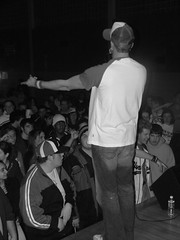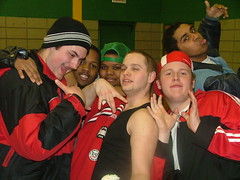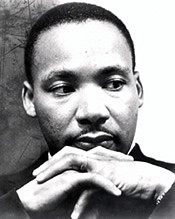I hate to surface this point again out of fear that people think I like controversy (although I kinda do) - but I read this article today that really got me fired up. I think we like to have a pocket size Jesus we can fit comfortably into our own little boxes and sometimes it's healthy to have those boxes shattered.
My Passion for the Multiethnic Jesus
by Efrem Smith
A lot has been said and written about Mel Gibson’s movie, The Passion of the Christ. There’ve been many articles and reviews by Christian leaders who talk about how great this movie is and how many lives will be impacted through it. I couldn’t wait to see the movie; I was excited by all the talk. But the images of the actor portraying Jesus caused me, an African- American senior pastor at a multiethnic urban church, to struggle with this movie even before I’d seen it.
For years when closing my eyes to pray, I’ve had to struggle to fight off the image of the white Jesus. Many Caucasians, and even those of other ethnicities, may be saying, “What’s the big deal? What difference does it make what color Jesus was?” And to be honest, it ultimately shouldn’t matter what color Jesus was, just as long as he truly is the Son of God who takes away the sins of the world.
White Jesus
But historically it has mattered to American and Western European Caucasians. To them, Jesus was white and must remain white, especially, it seems, in a major film that was offered for preview and preapproval to a mostly white, conservative, evangelical community. How many African American, Latino, or Asian American ministry leaders were given the opportunity to host a special prescreening and provide their thoughts? None that I know of.
The reason for this article isn’t to bash the movie. I look forward to seeing it as many times as I saw Matrix Revolutions, and I hope that lives are transformed through it. My issue is this: Was Jesus European when he walked the earth? If not, why is there still such an obsession with portraying him as such in our ever-increasingly multiethnic world? If ideological or institutional racism has nothing to do with perpetuating this image, and if it isn’t authentic to the Jesus of Scripture, than why do we keep doing it?
I’m not just trying to play the race card—my purpose comes from one who deeply wants to live in an intimate daily love affair with God, one who wants to communicate authentic biblical truth about Christ to a multiethnic congregation, and one who seeks true reconciliation within the larger body of Christ. This is why I wrestle with an ethnic portrayal of Jesus that is false. It doesn’t matter what color Jesus was...unless you lie about it.
Race-based Christianity
I believe the main reason Americans have constructed a mostly race-based Christianity narrated through the eyes and felt-needs of Caucasians is that there’s still an overall belief that Jesus in human form was, indeed, Caucasian. Even many black churches promote, consciously or not, a white Jesus, even though most of these churches stand against racism and other forms of social injustice.
Lifting up an image of a white Jesus, or a black one for that matter, contributes to one of the largest obstacles to building an authentic Christian community. In 1956, Martin Luther King, Jr. said that “the most segregated hour of Christian America” is “11:00 on Sunday morning.” In nearly forty years, that hasn’t changed. In some communities our image of Jesus speaks more to our history of racism, segregation, and slavery than it speaks to the Christ of Scripture.
Because it’s still very difficult to talk about a past from which we feel far removed (and from which we want so badly to be far removed ), we struggle to reconcile images of Jesus that speak more to our past divisions than to our present desires to be the reconciled and unified body of Christ. The current and dominant image of Jesus we put forward, as portrayed in The Passion of the Christ, points to our current and historic struggles with racism and segregation, not the Christ of the Bible.
Spirit and Truth
In John chapter 4, we see Jesus dealing head-on with segregation and racism:
“But the hour is coming, and is now here, when the true worshipers will worship the Father in spirit and truth, for the Father seeks such as these to worship him. God is spirit, and those who worship him must worship in spirit and truth.” The woman said to him, “I know that Messiah is coming” (who is called Christ). “When he comes, he will proclaim all things to us.” Jesus said to her, “I am he, the one who is speaking to you.”(John 4:23-26)
To worship God in spirit is to know God outside the natural realm—to be embraced by God beyond the tangible and natural touch, hug, or kiss. We gain the experience of true intimacy with God through prayer, praise, worship, meditation, and study. But promoting images of a false Jesus keeps the church from being whole and prevents us from worshipping God in truth. To know God in spirit but not in truth cripples the church’s ability to build God’s kingdom on earth.
Many people worship God in the spirit; they fast, pray, and so forth, but because they have a false natural reality of the authentic Jesus, they’re unable to communicate the Gospel of Jesus to those outside of their personal spiritual reality. God calls us as Christians to live in a balance of spirit and truth to become a community of true ambassadors for Jesus. By lifting up the authentic, multiethnic Jesus in human form, we dismantle the false Jesus and give life to the Christ-centered, multiethnic, transforming community.
Multiethnic Jesus
Matthew 1:1-17 gives the genealogy of Jesus from Abraham through Jesse to Joseph.
“The genealogy of Jesus is both Hamitic and Semitic. Originally both groups were people of color and closely associated with Africa. By modern American legal standards, anyone with a miniscule amount of African ancestry is considered black and accordingly this would include Jesus, even though in antiquity there were no such racial typologies…”
—from commentary on Matthew 1 in The Original African Heritage Bible
The human genealogy of Jesus points to a multiethnic heritage, not just an African one. Jesus shouldn’t be presented as European, Asian, or African. In Coming Together: The Bible’s Message in an Age of Diversity, Curtiss Paul DeYoung contends that in order for Jesus to blend in when his family fled to Egypt, his “appearance must have been quite similar to that of the people living in Egypt at the time” and that “Jesus, like other Jews in Palestine who had descended from the Hebrew people, was Afro-Asiatic.”
There’s something powerful about Jesus being multiethnic. God is on a mission of reconciliation through the death and resurrection of Jesus Christ. A multiethnic Jesus in human form points a scattered humanity back to a place of unity. Today’s youth—rural, urban, and suburban—are increasingly influenced by hip-hop, black, urban culture; yet they usually walk into homogenous youth groups staffed by leaders who are oblivious to multiculturalism.Within the youth culture, there’s a growing multiracial population that will tear down the walls of race and culture that have separated past generations.
Multiracial Culture
A May 8, 2000 Newsweek article entitled “Color My World” discusses this growth of a multiracial youth culture:
“Thirty years ago, only one in every 100 children born in the United States was of mixed race. Today that number is one in 19. In states like California and Washington it’s closer to one in 10. The morphing demographics give many teens a chance to challenge old notions of race.” And this article was written nearly four years ago.
According to a January 2004 USA Today Snapshot: in 1980 there were 651,000 interracial couples in the U.S. with one black or one white spouse; as of 2002 that number was 1,674,000. This will only continue the growth of the new multiethnic youth population.
If we intend to minister to this emerging “race-less” generation, can we continue to lift up a white Jesus? Jesus must be allowed to represent all of humanity and bring about redemption, reconciliation, and unity. A white, black, red, or yellow Jesus cannot accomplish the reconciliation, healing, and unity of a Jesus who is multiethnic. In the same manner, a segregated, homogenous church doesn’t have the natural and supernatural power of a Christ-centered, multiethnic Church.
Unification and Reconciliation
The Christian Church in the United States has missed out on many opportunities to be a part of God’s will because of our failure to dismantle a segregated church system based on a single-race Jesus. If we recognize the multiethnic Jesus in human form, we will be able to build a unified church on the foundation of a revelation of the authentic Jesus Christ.
When I think of the true passion of Jesus, I think of a multiethnic Jesus on the cross. I think of the Son of God with African, Asian, Jewish, and even European blood running through his veins. I picture this blood representing all of humanity running down his face, running from his pierced hands and feet. Jesus shed his blood for all of humanity.
A multiethnic Jesus can truly die for all of our sins. Ethnic groups still in recovery over oppression from the dominant culture can be reconciled to God side-by-side with their former oppressors.
Only the true biblical Jesus can reconcile us to God and one another. As the body of Christ, we must collectively refuse to accept any form of a counterfeit Jesus, black or white.




